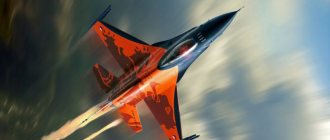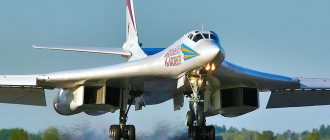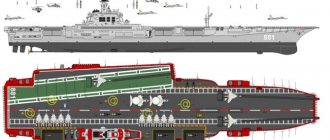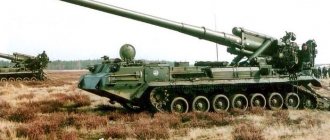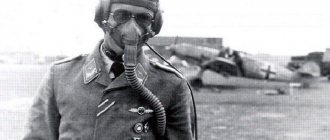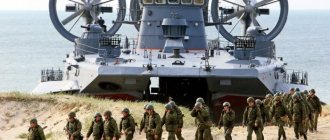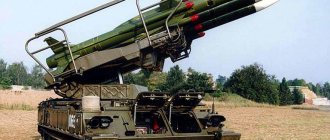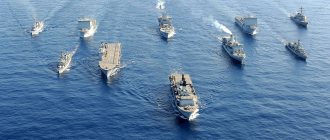"BBC" request redirects here; see also other meanings.
For the film, see Air Force (film).
Not to be confused with the BBC.
Slogan, aircraft and Flag of the Air Force of the Armed Forces of the USSR, on a stamp of the USSR Post, 1948 Flag of the Russian Air Force Emblem of the Russian Air Force Fifth generation fighter Su-57 Strategic bomber B-2 Spirit
Air Force
(Air Force) - a branch of the armed forces of the state, whose functions include fighting the enemy located in space, airspace, on the ground, on the surface of the sea and under water, as well as transporting troops, delivering property and weapons and military equipment, aerial reconnaissance, weather reconnaissance using aircraft.
The Air Force is an important element of the armed forces and includes:
- aviation, some call it military
; - special troops;
- services;
For example, in addition to aviation, the Russian Air Force has: units and subdivisions of reconnaissance, communications, radio engineering support and automated control systems, electronic warfare, engineering, radiological and biological protection, surveying, search and rescue, meteorological, aeronautical, moral-psychological, logistical and medical support , parts of support and protection of military command and control bodies)[1];
In various states, the Air Force can act as an independent branch of the Armed Forces or together with the Air Defense Forces (APVO).
Having received its first combat use in 1911, the Air Force already played a significant role in the First World War. In the Second World War, their use was widespread; they had a major influence on solving the strategic problems of the warring parties. During this war, the air forces of all warring countries carried out over 12 million combat sorties, dropping at least 5 million tons of aerial bombs (100 times more than in 1914-1918). During the war years, the warring states produced at least 700,000 aircraft, of which 90,000 were in service by the end of the war[2].
In the post-war period, the role of the Air Force continues to strengthen, and the goals and objectives assigned to it continue to expand.
Types of aviation forces in the Air Forces of the Armed Forces of the USSR and Russia:
- long-range (strategic);
- frontline;
- military transport;
- sanitary
The ground forces, navy and air defense forces of a state may include sea (deck-based and shore-based) aviation and air defense aviation, respectively. There may also be aviation of the Ground Forces (also known as army aviation), as well as aviation of ground-based strategic nuclear forces (for example, aviation of the Strategic Missile Forces in Russia). These structures are usually not part of the state's air force.
The armed forces of Great Britain, Germany, Israel, China, Russia, the USA, France, Turkey and Saudi Arabia have the production of their own aircraft and the most powerful air forces. The oldest air force in the world is the Royal Air Force of Great Britain, created as a separate branch of the armed forces on April 1, 1918[3].
The basis of the air forces of most developed countries currently consists of fourth-generation aircraft. At the same time, the development of fifth-generation aircraft is actively underway. The main tasks that are set for the developers of new generation aircraft are: optimization for certain types of combat missions, reduced radar signature and high maneuverability characteristics at supersonic speeds[4].
Formations[ | ]
The main formations (units, units, formations and associations) of the branch of force (aviation) of the type of armed forces - the Air Force or Navy (VVF) - are presented.
| Name of formations | Kind of forces | Included | Permanent or temporary |
| Crew | Aviation (strategic, army, transport, naval) | Link (squad) | Permanent |
| Link (squad) | Aviation (strategic, army, transport, naval) | Squadron | Permanent |
| Squadron | Aviation (strategic, army, transport, naval) | Regiment, separate squadron (division) | Permanent |
| Regiment, separate squadron (division) | Aviation (strategic, transport, maritime) | Brigade | Permanent |
| Brigade | Aviation (strategic, army, transport, naval) | Division (squadron) | Permanent |
| Division (squadron) | Aviation (strategic, army, transport, naval) | Air Corps | Permanent |
| Air Corps | Aviation (strategic, army, transport, naval) | Air Force | Permanent |
| Air Force | Aviation (strategic, army, transport) | Air Force (Air Force) | Permanent |
| Air Force (Air Force) | Aviation | Armed forces | Permanent |
History of military aviation
Bulgarian pioneers
The Bulgarian Tsar Ferdinand
the Man had just begun to master the airspace, and the military was already thinking about how to use airplanes for the needs of the army. Bulgaria took the first steps in this direction. Tsar Ferdinand became very interested in aviation, which contributed to its rapid introduction into the life of the country. The Bulgarian army first used aircraft for reconnaissance of enemy positions during the First Balkan War (1912−1913). By the time the First World War began, combat aircraft were already in service with most participating countries. Russia had the most powerful military aircraft fleet - 263 aircraft. The German Air Force consisted of 232 aircraft, France took third place in this indicator - 156. Against this background, the achievements of Great Britain (90 aircraft) and Austria-Hungary (65) look rather modest.
Russian aviation and Ilya Muromets
Ilya Muromets by Igor Sikorsky
The Russian Empire has achieved enormous success in terms of the development of military aviation. The annual costs of building new aircraft exceeded a million rubles. Since 1908, there was an imperial flying club in the country, the head of which was Grand Duke Alexander Mikhailovich. However, the club members were mainly engaged in the development of the construction of airships. The first airplanes appeared in the country in 1909, and already in 1910 Russia began creating its own combat aircraft. The industry developed quickly. By 1914, at least five aviation schools had opened in the country, and four aircraft assembly plants were operating. A year before the war, the first strategic bomber in human history was built. The four-engine aircraft, created according to the design of Igor Sikorsky, was named “Ilya Muromets”. The airplane set a record for carrying capacity (more than a ton). However, then in 1913, no one yet suspected that the Ilya Muromets would become a strategic bomber; Sikorsky himself conceived it as a passenger aircraft, but the war made its own adjustments to these plans. The Muromets set off on their first combat mission in February 1915. By the end of the war, the Russian Empire had 60 such aircraft in service. By the way, for the time being, the Russian Empire used aircraft only for reconnaissance and artillery fire adjustment. Machine guns appeared on airplanes only in 1915. By that time, many Russian aircraft had already been lost. The military command even issued a special decree, which noted that airplanes could be used only in cases of extreme necessity, because the country was faced with serious problems in the production of new aircraft. For example, we almost always had to purchase motors abroad.
Russian ace Pyotr Nesterov was the first in history to use an aerial ram
Germany and old planes
Monoplane "Taube"
At the beginning of the war, the German Empire had the second largest aircraft fleet (after Russia). However, the military command did not pay due attention to aviation. German generals, of course, did not consider the aircraft unpromising from a military point of view (as was the case with tanks), but nevertheless, they relied primarily on the morale of the soldiers, and not on the latest technological achievements. And so it turned out that most of the 232 German aircraft were obsolete. Yes, yes, despite the fact that aviation was born less than ten years before the start of the war, many models were already outdated. These included the German Taube monoplane, which was in service in the German Empire. In service, this is also a strong word. Germany produced almost no aircraft for the army; the military simply confiscated existing civilian airplanes. Until 1916, aviation was not even considered a separate branch of the military in Germany. The military generally gave priority to aeronautics, so the emphasis was on building airships. It was they who were used for raids on London in 1915. It was they who allowed Germany to maintain dominance in the skies for a long time. However, it was the German Empire that achieved tremendous success in the use of fighters. With the help of Dutch engineer Anton Fokker, the German military solved the problem of effectively using a machine gun in air battles. Previously, its use was hampered by the propeller, the rotation of which created an obstacle to fire. Fokker developed a synchronizer, now the machine gun fired only when there was no propeller in its path.
German fighter " Fokker E.I.
"
With the new fighters, Germany inflicted colossal losses on the Entente Air Force. The phenomenon was even called the Fokker Scourge.
Max Immelman "The Eagle of Lille" - one of the first German aces of the First World War.
France and engineering
French fighter "Moran-Salnier "
In France, the development of military aviation was given great importance. The government allocated 6 million francs annually for the construction of new aircraft and technology development. The main task of the aircraft was to carry out raids on Alsace-Lorraine. As a result, it was the French who were the first to install machine guns on airplanes. It was the French engineers who came up with the idea of the fighter. It was the French pilots who carried out the most complex operations to track down and destroy German airships. For these purposes, the famous Morand-Salnier fighters, armed with one machine gun, were used. Their appearance at the front allowed France to achieve short-term air superiority over Germany. However, all efforts came to naught when the German Fokkers described above were put into action. However, France did not abandon the release of Morans. By the end of the war, the country's aviation numbered over 600 such fighters. Later, French military engineers proposed installing missiles on fighter jets. The idea has been discussed for a long time. As a result, missiles did appear on French aircraft, but closer to the end of the war.
World War I missile-carrying aircraft
UK and organization
And this is what British aircraft carriers looked like during the First World War;
peaceful aviation was rapidly developing, and even before the war the army made several large orders to industrialists for the production of combat aircraft. However, by the summer of 1914, the British were noticeably behind Germany, France, and Russia. It was primarily a matter of quantity. 90 - aircraft, and this despite the fact that Germany and Russia had more than 200 of them. But the British were the first to separate aviation into a separate branch of the military - the Royal Flying Corps. Somewhat later, RFK was completely removed from the subordination of the War Ministry and legally formalized as an independent structure, but this happened already in 1918. By the way, Great Britain was late in creating fighters and bombers. Airplanes were used exclusively for reconnaissance and photography, and in battle, preference was given to airships. The British government was prompted to change by the successes of the German Fokkers. It was clear that without air superiority over Germany, success in the war could not be achieved. But then a new problem arose - financial. The development of fighters more advanced than the Fokkers required huge financial expenditures. Building bombers would also cost a pretty penny. Not all high-ranking military officials considered it necessary to develop aviation. It took months of difficult negotiations to convince them.
Source: Amateur
Big Ten: The World's Largest Military Aircraft
The still not very long history of aviation is replete with episodes when in different countries, at different times and for different reasons, gigantomania came into military fashion, leading to the construction of huge flying machines. This material presents 10 such aircraft built over the past three quarters of a century.
Junkers Ju 390
This aircraft was built in Germany on the basis of the four-engine Junkers Ju 290 in 1943 and was intended for use as a heavy transport, maritime patrol aircraft, and strategic bomber. The Germans planned to build 26 such aircraft, with which, in theory, it was possible to bomb even the territory of the United States, but in reality they were able to build only two machines. The aircraft's wingspan was 50.3 meters, its length was 34.2 meters, and its flight range was up to 9,700 kilometers.
Antonov An-225 "Mriya"
masterok.livejournal.com
The An-225 Mriya aircraft was developed by the Antonov design bureau in the 1980s. It is the longest (84 meters) and heaviest (maximum take-off weight 640 tons) aircraft ever built. "Mriya" was originally created to transport the reusable spacecraft "Buran", as well as various large-sized components of the launch vehicle from the production site to the launch site, and was produced in a single copy (the second copy is approximately 70% ready since Soviet times). . After the completion of the Energia-Buran program, the An-225 was mothballed for eight years. In the early 2000s, the aircraft was restored by Ukrainian companies, and currently it performs commercial cargo transportation.
Messerschmitt Me 323 "Gigant"
The German Messerschmitt Me 323 was the largest production land aircraft of World War II. In total, just over 200 of them were built. It was designed and built in preparation for the planned invasion of Great Britain. Initially it was created as a heavy glider Me 321, but in 1941 it was decided to build a version of this glider with a motor. With a payload capacity of up to 23 tons, this fabric and plywood-covered aircraft was used by the Germans primarily to supply troops in North Africa, although it was also seen on the Eastern Front.
Blohm & Voss BV 238
This German flying boat with a wingspan of 60.17 meters made its first flight in March 1944 and was built in a single copy. The Blohm & Voss BV 238 was the largest aircraft built to that date, and, ironically, became the largest aircraft destroyed during World War II. The plane was based on Lake Schalsee in northern Germany and was sunk in September 1944 as a result of an attack by a group of American P-51 Mustang fighters. According to another version, it was destroyed by British Hawker Typhoon in May 1945.
Martin JRM Mars
The large Martin JRM Mars transport seaplane was built in limited numbers (1 prototype and 6 production) for the US Navy during World War II. It was created as a “flying dreadnought” - a long-range patrol aircraft. After the war, the four surviving Mars, written off for scrap in 1959, were bought by Canadian timber merchants and converted into flying tankers for fighting forest fires. After 2012, there is still one Martin JRM Mars in service.
Convair B-36 Peacemaker
XB-36 prototype (right) next to the B-29 Superfortress
The B-36 Peacemaker is an American intercontinental bomber, the largest combat aircraft in the history of aviation in terms of wingspan (70.1 meters). The first flight took place in August 1946. A total of 384 aircraft were built.
Convair XC-99
The XC-99 is an American prototype heavy cargo aircraft built using parts from the B-36 bomber. Built in a single copy, it made its first flight on November 24, 1947, and in 1949 it entered service with the US Air Force. During the Korean War, the XC-99 made intercontinental flights in the interests of the US Army. The last flight was performed on March 19, 1957.
Boeing B-52 Stratofortress
The B-52 intercontinental strategic bomber made its first flight in April 1952 and replaced the Convair B-36. As one of the main delivery vehicles for American nuclear weapons, the B-52 participated in several military conflicts, during which only conventional weapons were used from its board. The US Air Force plans to operate the B-52 until at least the 2040s. The aircraft's wingspan is 56.39 meters.
Hughes H-4 Hercules
The prototype of the American military transport aircraft was designed as a transatlantic transport for the rapid transfer of troops to the European theater of operations. It had a wooden fuselage and made only one short flight on November 2, 1947. The Hercules has the largest wingspan (97.54 meters) of any aircraft built and flown in history.
Lockheed C-5 Galaxy
American strategic military transport aircraft that made its first flight on June 30, 1968. A total of 131 vehicles of this type were produced. The Lockheed C-5 Galaxy has been used by Americans in every major conflict since 1969, including the wars in Vietnam, Iraq, Yugoslavia and Afghanistan, as well as in support of allies such as Israel during the Yom Kippur War. The aircraft has a wingspan of 67.88 meters and a maximum take-off weight of 380 tons (in the C-5B modification).
The material was prepared using information from the resource warhistoryonline.com
Passenger aircraft
Let's start our review of civil aviation models with them. This type of air vehicle, as the name implies, is designed to transport passengers.
The first production aircraft to transport civilians is considered to be the same domestic Ilya Muromets, which in the future was converted into a bomber. He made his first flight from St. Petersburg to Kyiv with sixteen passengers back in 1914.
The most popular airliner during the history of aviation is the American Douglas DC-3, which made its first aviation flight back in 1935. Various modifications of it are still in use today. For example, the Soviet version of this aircraft was the Li-2.
The first aircraft were described above. The names of the main competitors in the modern passenger aviation market are Boeing and Airbus.
Soviet passenger aircraft
The Soviet passenger aviation industry was also represented at a decent level. Most of the models are Aeroflot aircraft. Names of the main brands: Tu, Il, An and Yak.
The first domestic jet airliner was the Tu-104, released in 1955. The Tu-154, which first took off in 1972, is considered the most popular Soviet passenger aircraft. The 1968 Tu-144 acquired legendary status as the world's first airliner that managed to break the sound barrier. It could reach speeds of up to 2.5 thousand km/h, and this record has not been broken to this day. At the moment, the last operating model of the airliner developed by the Tupolev design bureau is the Tu-204 aircraft produced in 1990, as well as its modification Tu-214.
Naturally, besides Tu, there are other Aeroflot aircraft. The names of the most popular: Il-18, Il-114, Il-103, An-24, An-28, Yak-40 and Yak-42.
Comparison of Russian and US aviation
More than a year has passed since the first publication of this post. During this time, I learned a lot about myself and listened to a certain amount of “flattering and witty” reviews. Fortunately, among them there was a lot of constructive information, thanks to which I adjusted the data on the quantitative composition of aviation. Ours and an incredible ally. But before moving on to the post itself, I want to say the following:
A) In modern warfare there are no single “Ubercrafts” capable of destroying everyone and everything. War is multimodal mutual destruction. It involves aviation, air defense, motorized infantry, reconnaissance, artillery, etc. Even more space is given to chance, combat coordination, weather conditions, and the morale of the troops. Therefore, there is not and will not be a situation where the F-35 will fight only with the Su-35S or FA, and everything else will not interest it. “And everything else” will not be interested in the F-35. There are no autonomous individual air duels. There are opportunities to shoot down someone, bomb someone, fight someone off, get away from something.
B) I don’t care about the quantitative composition of US fighter and strike aircraft. The reasons are as follows: 1) we and the United States can only exchange nuclear weapons with subsequent attacks by “strategists”, if, of course, there is something left by that time; 2) The United States will not be able to concentrate such a number of aircraft near our border. Aircraft carriers only carry certain types of aircraft. You also need to swim without incident. Suitable airfields in Europe, located within the combat radius of their aircraft, may simply not be enough to accommodate such a number of vehicles. Don’t forget about “gifts with surprises” from our tactical missile systems (possibly with tactical nuclear weapons), army intelligence and, possibly, ICBMs. I think it’s clear what these “fields” will turn into. Plus, the issue of supplying and ensuring all this pornography equipment is acute.
Let's start. For those who value their time, I give conclusions at the very beginning:
1) The US Air Force is superior to the Russian Air Force in general quantitative terms by about 4 times. And 2 times the number of combat aircraft in operation;
2) the trend for the next 5-7 years is a major modernization of the Russian aviation fleet;
3) PR, advertising and psychological warfare are the favorite and effective method of conducting US military operations. An enemy who is psychologically defeated (by lack of faith in the strength of his weapon, leadership, etc.) is already half defeated.
So, let's begin.
The US Air Force/Navy/Guard aviation is the most powerful in the world.
Yes this is true. The total strength of US aviation in 2013 was 2,960 (1,593 in service) fighters, 162 (95) bombers, 424 (255) attack aircraft, 1,795 tankers and transporters and more than 1,100 technical equipment. Total ~ 8,250 cars.
For comparison: the total strength of the Russian Air Force as of May 2013 is 897 (760) fighters, 321 (88) bombers, 329 (153) attack aircraft, 372 transport aircraft, 18 tankers, 200 technical equipment. Total ~ 2,200 car.
However, there are nuances, the main one of which is that US aviation is aging, and its replacement is delayed.
Let me explain what I mean by “obsolescence.” If you look at the table, you will see that the F-15/16 accounts for just over 50% of the entire US aircraft fleet. These were good aircraft for their time, but even then they were inferior to our MiG-29 and Su-27 in a number of indicators (especially from the point of view of operation in front-line conditions), which greatly “baffled” their American colleagues.
What are we seeing now? Our country 20 years ago followed the path of democracy and capitalism with the Su-27 and MiG-29. Thanks to a competent export policy, the vehicles were able to survive, and then increase their potential to the Su-35S and MiG-35. Those. engineers and designers did not have to create aircraft literally from scratch. Of course, any letter in the index can mean that we are looking at a completely different machine, many times superior to its predecessor. But the airframes of the MiG-29SMT and the Su-27SM3 or Su-35S remained the same. And these are completely different costs.
What about the USA? They entered the crisis with the F-22 (an all-new vehicle) out of production, and the unfinished F-35 (an all-new vehicle), as well as a massive fleet of good but already obsolete F-15/16s. My reason for my nonsense is that at the moment the United States does not have a relatively cheap reserve that would allow it to maintain a quantitative (and in some ways qualitative) superiority over the Russian Federation without multibillion-dollar investments in new developments. In 5-7 years they will have to write off about 450-500 F-15/16s, and by this time we will have about 250 new Su-27SM and SM3, 64 MiG-29SMT, 96 Su-35S and 60 Su-30SM.
That is,
the Russian aviation fleet will be actively modernized over the next 5-7 years .
Including through the creation of completely new aircraft. At the moment, contracts for production/modernization have been concluded until 2022: MiG-31BM - 100 units; Su-27SM - 96 units; Su-27SM3 - 12 units; Su-35S - 95 units; Su-30SM - 60 units; Su-30M2 - 4 units; MiG-29SMT - 50 units; MiG-29K - 24 units; MiG-35 - 37 units. (?); Su-34 - 124 (184) units; FA - 60 units; IL-476 - 100 units; An-124-100M - 42 units; A-50U - 20 units; Tu-95MSM - 20 units; Yak-130 - 65 units. In fact, by 2022, just over 850 new machines will be put into operation.
To be fair, I note that Carthage should be destroyed. The United States in 2001 planned to purchase about 2,400 F-35s by 2022. However, at the moment, all deadlines have been missed, and the adoption of the aircraft has been postponed until mid-2015. In total, the United States currently has 63 Lightning 2s.
We have only a few 4++ aircraft and no 5th generation, but the USA already has hundreds of them.
Yes, that's right, the United States has 141 F-22As in service. We have 48 Su-35S. PAK-FA is undergoing flight tests. But it is necessary to take into account: A) F-22 aircraft have been discontinued due to 1) high cost ($280-300 units versus 85-95 for the Su-35S); 2) schools with tail fins (collapsed under overload); 3) glitches with the fire control system (fire control system); 4) the absence of a threat to the United States from anyone’s aircraft (we will fight with them with strategic nuclear forces), problems with ventilation and the impossibility of selling it to anyone.
B) The F-35, with all its PR, is very far from the 5th generation . And there are plenty of problems: either the EMDS fails, or the airframe breaks, or the control system lags.
C) By 2022, the troops will receive: Su-35S - 150 units, FA - 60 units.
D) Comparing individual aircraft outside the context of their combat use is incorrect. Combat is high-intensity, multi-modal mutual destruction, where much depends on specific topography, weather conditions, luck, training, coordination, morale, etc. Individual combat units do not solve anything. On paper, a conventional ATGM will tear apart any modern tank, but in battle conditions everything is much more prosaic.
Their 5th generation is many times superior to our FA and Su-35S.
This is a very bold statement.
A) We should start with the fact that the F-22 was created to fight our Su-27 and MiG-31. And that was quite a long time ago. The FA is being created to confront the 4th generation, which it will meet in Europe, and the F-35, which, in terms of its parameters, is far from the most formidable “UF.”
B) If the F-22 and F-35 are so cool, why are they: 1) So carefully hidden? 2) Why don’t they allow EPR measurements to be taken? 3) Why aren’t there demonstration dogfights or at least simple comparative maneuvering, like at air shows?
C) If you compare the performance characteristics of our and American aircraft, you can find a lag in our aircraft only in terms of ESR (for the Su-35S) and detection range (20-30 km). 20-30 km in range is not so critical for the simple reason that the missiles that we have exceed the US AIM-54, AIM-152AAAM in range by 80-120 km. I'm talking about RVV BD, KS-172, R-37. So, if the F-35 or F-22 radars have a better range against stealth targets, then how will they shoot down this target? And where is the guarantee that the “contact” will not fly “low and low”, hiding in the folds of the terrain?
C) There is nothing universal in military affairs. There are multi-role aircraft capable of both operating against air targets and on the ground, depending on their weapons. An attempt to create a universal aircraft capable of performing the functions of an interceptor, bomber, fighter and attack aircraft leads to the fact that universal becomes synonymous with the word mediocre. War recognizes only the best models in their class, tailored to solve specific problems. Therefore, if it’s an attack aircraft, then it’s a Su-25SM, if it’s a front-line bomber, it’s a Su-34, if it’s an interceptor, it’s a MiG-31BM, if it’s a fighter, it’s a Su-35S.
And even more so, the F-22 is not a universal aircraft. It was created to gain air supremacy. To destroy the Su-27 and MiG-31, which posed a considerable danger to American strategic and attack aircraft. Its main task is airspace control. And in this category, aircraft development is subject to a single slogan - “not an gram (not a pound) on the ground.” So there is no need to talk about any “super capabilities” of the F-22.
D) War is not a comparison of who has the longest spear. What is more important is who will have the best spears in terms of price/quality/quantity. Our potential friend’s planes cost a lot of money, and I don’t even want to remember how much they spent on R&D: $400 billion for the F-35 (and the program has not yet been completed) and $50 billion for the F-22. For comparison, we plan to spend $10 billion of budget money on FA.
The United States has significant superiority in strategic aviation forces.
This is wrong.
The US Air Force already has 95 strategic bombers in service: 44 B-52N, 35 B-1B and 16 B-2A. The B-2 is exclusively subsonic and carries only free-falling bombs from nuclear weapons. B-52N - subsonic and old, . B-1B is no longer a carrier of nuclear weapons (START-3). Compared to the B-1, the Tu-160 has a 1.5 times greater take-off weight, 1.3 times greater combat radius, 1.6 times greater speed and a greater load in the internal compartments. By 2025, we plan to put into operation a new strategic bomber (PAK-DA), which will replace the Tu-95 and Tu-160. The United States extended the service life of its aircraft until 2035, and postponed the development of a new “strategist” and a new ALCM until 2030-2035.
If you compare their ALCMs (cruise missiles) with ours, then everything turns out quite interesting. AGM-86 ALCM has a range of 2400 km. Our X-55 is 400-4500 km, and X-101 is 7000-8500 km. Those. The Tu-160 can shoot at enemy territory or AUG without entering the affected area, and then calmly escape at supersonic speed (for comparison, the maximum operating time at full thrust with afterburner for the F/A-18 is 10 minutes, for the 160 - 45 minutes). It also raises deep doubts about their ability to overcome a normal (non-Arab-Yugoslav) air defense system.
* * *
To summarize, I would like to note once again that modern air warfare is not about individual battles in the air, but about the work of detection systems, target designation, suppression, etc. And there is no need to consider the aircraft (be it the F-22 or FA) as a proud celestial horseman. There are a lot of all sorts of nuances around in the form of air defense, electronic warfare, ground-based RiRTR, weather conditions, flares, LTC and other joys that will not allow the pilot to even reach the target. Therefore, there is no need to compose sagas and sing hymns to single fantastic winged ships that will bring laurels of victory to the feet of those who created them and destroy everyone who dares to “raise a hand” against their creators.
9.Lockheed Martin F-16 Fighting Falcon (USA)
Just a couple of years ago, the Falcon, ranked ninth in the ranking of the best fighters in the world, was the most common combat aircraft in the world. Low cost and quality indicators made it the main export product of the American Air Force. As of today, there are 4,750 F-16 fighters worldwide. The modernized version will be produced at least until the end of 2022. Pictures of this aircraft were repeatedly captured by military reporters; it managed to take part in 100 conflicts, the most famous of which are the NATO Operation against Yugoslav troops and the Iraq War. The Israeli Army's F-16 Fighting Falcons are the most capable combat fighters. According to official data, they have forty air victories.


